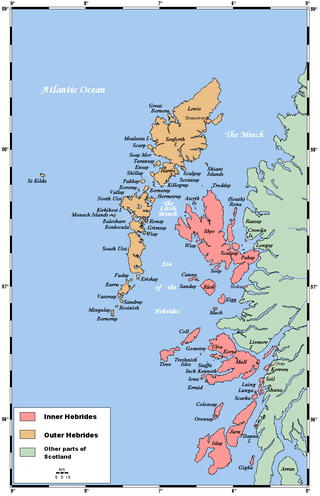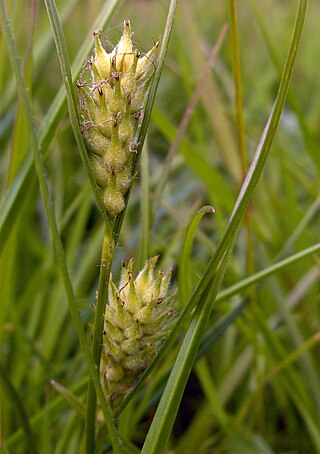Hirta is an island in Scotland.
Hirta may also refer to:

St Kilda is an isolated archipelago situated 64 kilometres (40 mi) west-northwest of North Uist in the North Atlantic Ocean. It contains the westernmost islands of the Outer Hebrides of Scotland. The largest island is Hirta, whose sea cliffs are the highest in the United Kingdom; three other islands were also used for grazing and seabird hunting. The islands are administratively a part of the Comhairle nan Eilean Siar local authority area.
Hirta is the largest island in the St Kilda archipelago, on the western edge of Scotland. The names Hiort and Hirta have also been applied to the entire archipelago. Now without a permanent resident population, the island had nearly all of St Kilda's population of about 180 residents in the late 17th century and 112 in 1851. It was abandoned in 1930 when the last 36 remaining inhabitants were evacuated to Lochaline on the mainland.

Viola hirta is a species of the plant genus Viola. It is also called the hairy violet. As with the sweet violet, no fossil seeds of this species have been found. It is confined to the cold temperate zone, in Europe, north and west Asia, extending as far as northwest India. It is absent in Wales from Brecon and Radnor, Pembroke, Cardigan, Merioneth, and from Mid Lancs, and the Isle of Man, but elsewhere it is universal. In Scotland it does not occur in Roxburgh, Berwick, Haddington, Edinburgh, Fife, Forfar, Kincardine. From Forfar it ranges to the south of England, and is found at a height of 1000 ft. in Yorks. It occurs also in Ireland.

Rudbeckia hirta, commonly called black-eyed Susan, is a North American flowering plant in the family Asteraceae, native to Eastern and Central North America and naturalized in the Western part of the continent as well as in China. It has now been found in all 10 Canadian Provinces and all 48 of the states in the contiguous United States.

Rudbeckia is a plant genus in the Asteraceae or composite family. Rudbeckia flowers feature a prominent, raised central disc in black, brown shades of green, and in-between tones, giving rise to their familiar common names of coneflowers and black-eyed-susans. All are native to North America, and many species are cultivated in gardens for their showy yellow or gold flower heads that bloom in mid to late summer.

Miconia crenata, commonly called soapbush, clidemia or Koster's curse, is a perennial shrub. It is an invasive plant species in many tropical regions of the world, creating serious damage.
Brown-eyed Susan is a common name for several plants and may refer to:
Yellow coneflower is a common name for several plants and may refer to:

The St Kilda field mouse is a subspecies of the wood mouse that is endemic to the Scottish archipelago of St Kilda, the island 40 miles (64 km) west of Benbecula in the Outer Hebrides, and 100 miles (160 km) from mainland Scotland. Unique to the islands, the mouse is believed to have arrived on the boats of Viking settlers more than a millennium ago. It is not to be confused with the St Kilda house mouse, a subspecies of the house mouse which is now extinct.

The flora and fauna of the Outer Hebrides in north west Scotland comprises a unique and diverse ecosystem. A long archipelago, set on the eastern shores of the Atlantic Ocean, it attracts a wide variety of seabirds, and thanks to the Gulf Stream a climate more mild than might be expected at this latitude. Because it is on the Gulf Stream, it also occasionally gets exotic visitors.

Hydrangea hirta, also known as the "nettle-leaved hydrangea", is a species of flowering plant in the family Hydrangeaceae that is native to East Asia. Due to the beauty and sturdiness of the species' flowers it can be found outside of its range being used for horticultural and landscaping purposes, and is found in gardens in countries including the United Kingdom and the United States.
H. hirta may refer to:
R. hirta may refer to:
C. hirta may refer to:
Musa hirta is a tropical Asian species of plant in the banana family native to Sarawak on the island of Borneo, in Malaysia. It is one of fourteen species of Musa endemic to the island of Borneo. It is placed in section Callimusa, having a diploid chromosome number of 2n = 20.

Carex hirta, the hairy sedge or hammer sedge, is a species of sedge native across Europe. It has characteristic hairy leaves and inflorescences, and is the type species of the genus Carex.
Taraxacum pankhurstianum, also known as the St Kilda dandelion, is a species of dandelion that was identified as new in 2012 after being cultivated at the Royal Botanic Garden Edinburgh from seeds collected two years previously on the island of Hirta, the largest island in the St Kilda archipelago, on the western edge of Scotland.
Hyoseris hirta may refer to two different species of plants:

The lemon tree borer, also known as the whistling beetle or the singing beetle, is a longhorn beetle endemic to New Zealand. Its larvae are generalist feeders, boring into the wood of a wide variety of trees, native and introduced. When citrus orchards were first established in New Zealand, this beetle started inflicting serious damage, and so gained the name "lemon tree borer". Four species within the genus Oemona have been identified, suggesting that more species could be found. When disturbed by predators or humans, the adult beetle stridulates creating a "rasp" or "squeak" sound by rubbing its thorax and head together against an area of thin ridges. Māori would eat a liquid called "pia manuka", which was produced by manuka trees when its wood was damaged by the larvae. When Captain Cook first arrived in NZ, his naturalists, Banks and Solander, collected a lemon tree borer in their first collection between 1769 and 1771. This oldest collected specimen can be found in the British Museum. A few years after the first collection, the species would be first described by the Danish naturalist Fabricius in 1775.